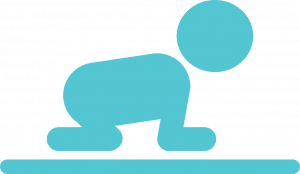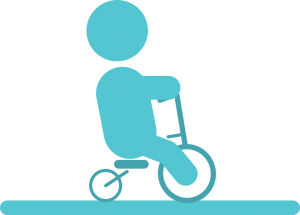Child development is the process by which the dependent infant matures into the independent adult, functioning within society. It is a complex interweaving of biology, psychology and environment where each skill builds on the ones that have come before and provides a foundation for those skills yet to develop.
Development in humans follows a predictable pattern and a rough schedule but no individual develops in exactly the same manner as any other. It follows an orderly pattern (unlike almost everything else regarding children); from top to bottom, central to outer and simple to complex. What is important, when considering normal development, is progress and parity; that children are moving forward in the different areas of development at roughly the same rate.
Disparity in progress between areas of the body (e.g. the right side and the left or the lower limbs and the upper limbs) or between domains of development (see below) is concerning, as is regression (i.e. loss of previously attained skills).
This article will outline the typical stages of development that children go through. The features typically seen at each age are described below.
Gross motor development
Gross motor development refers to the abilities required for big movements and activities, such as sitting, standing, walking, running and climbing stairs.
| Age | Feature |
| 1 month | Symmetrical movements in all limbs
Normal muscle tone Head lag when pulled up
|
| 3 months | Almost no head lag when pulled to sit
Lifts head and chest when prone
|
| 6 months | Rolls from back to front
When held, stands and sits with a straight back Bears most of own weight
|
| 9 months | Sits without support
Stands holding onto furniture Moves around the floor, e.g. wriggling, commando crawling
|
| 12 months | Stands without support
Crawls, bottom shuffles or ‘bear-walks’ Cruises along furniture May walk unsteadily
|
| 15 months | Generally walks without support
Crawls upstairs
|
| 18 months | Walks steadily, stopping safely
Squats to pick up a toy Climbs stairs holding a hand or a rail
|
| 24 months (2 years) | Runs safely
Throws a ball overhand Walks up and down stairs, both feet on each step
|
| 30 months | Jumps on 2 feet
Kicks a ball
|
| 36 months (3 years) | Walks backwards and sideways
Rides a tricycle Catches a large ball with arms outstretched |
| 48 months (4 years) | Stands, walks and runs on tiptoes
Runs up and down stairs |
| 5 years old | Hops
Catches a ball Heel-toe walking May ride a bike
|
References
| (1) | Kapoor, Barnes, “Developmental Assessment”, Paediatrics, Edition 4, 2013 |
| (2) | Lissauer, W. Carroll, “Normal Child Development, Hearing and Vision”, Illustrated Textbook of Paediatrics, Edition 5, 2017 |
| (3) | Sheridan, M. D., From birth to five years; children’s developmental progress, 3rd edition revised and updated by A. Sharma and H. Cockerill, Routledge 2007 |
| (4) | understood.org |
| (5) | thecommunicationtrust.org.uk |
| (6) | Meggitt, C., Child development, an illustrated guide, 2nd edition, Heinemann 2006 |
| (7) | kidsmatter.edu.au |
Authors:
1st Author: Trainee doctor Hannah Murray
Senior review: Dr Louise Ingram (Paediatric specialist registrar)











